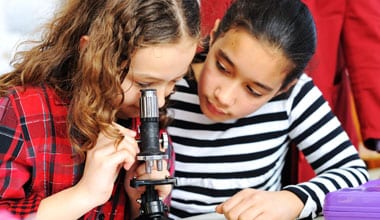
TCI’s Bring Science Alive! programs for elementary and middle school classrooms are rich with real-world phenomena that stoke students’ curiosity about the world around them. Students explore an anchoring phenomenon throughout a unit, as well as supporting and local phenomena in each lesson that connect to the anchoring phenomenon.
Let’s take a deeper dive into phenomena in Bring Science Alive! and walkthrough examples of phenomena in an elementary unit and a middle school unit.
Phenomena for Elementary Science
In Bring Science Alive! for elementary classrooms, there are many opportunities to engage students with phenomena. Let’s explore phenomena in the Plant and Animal Structures unit from Bring Science Alive! Exploring Science Practices Grade 4.
Anchoring Phenomenon
Each unit in Bring Science Alive! is structured around an anchoring phenomenon that ties into a larger storyline. The anchoring phenomena are compelling and get students asking questions. In the Plant and Animal Structures unit, students examine the eyes of different animals and explore the anchoring phenomenon: Animals have eyes, but the location of the eyes is different depending on the animal.
At the beginning of each unit, students engage with the anchoring phenomenon and develop an initial model to explain it. They continuously revise the model as they go through each lesson and gather more information. Finally, students explain the anchoring phenomenon in the unit’s Performance Assessment, in which they examine the structures animals and plants use for survival to design a new legendary creature.
Lesson Phenomena
To provide greater flexibility and support, each lesson in a unit includes a lesson phenomenon that examines one part of the unit’s anchoring phenomenon.
For example, one lesson in the Plant and Animal Structures unit focuses on animal structures for sensing the environment. In that lesson, students make sense of the lesson phenomenon: Owls have large eyes. They explore how structures for sensing, such as eyes, help animals survive.
At the end of each lesson, students create a claim supported by evidence and reasoning to explain the lesson phenomenon. They also connect what they learned in the lesson to the unit’s anchoring phenomenon about the location of eyes on different animals.
Local Phenomena
In each lesson, students also have an opportunity to build a deeper, personal connection to the anchoring phenomenon through direct observation or by conducting research to find out more about a phenomenon in their local area.
For example, in the Plant and Animal Structures unit, one lesson introduces the concept of animal structures used for movement and protection. Students can observe how animals in a local ecosystem move and respond to their environment.
Phenomena for Middle School Science
In Bring Science Alive! for middle school classrooms, there are many opportunities to engage students with phenomena. Let’s explore phenomena in the Light Waves unit from Bring Science Alive! Waves.
Anchoring Phenomenon
Students explore a compelling anchoring phenomenon that ties into a real-world storyline throughout a unit. The phenomenon is designed to engage students and get them asking questions from the start.
In the Light Waves unit, students examine the effects of light and explore the anchoring phenomenon: Light creates effects that are not so easy to explain, such as making diamonds sparkle, making lines at the bottom of a pool appear wavy, and making rainbows form near waterfalls.
At the beginning of each unit, students engage with the anchoring phenomenon and develop an initial model to explain it. They continuously revise the model as they go through each lesson and gather more information. Finally, students explain the anchoring phenomenon in the unit’s Performance Assessment, in which they design their own exhibit in a light show that conveys an artistic interpretation of key properties of light, such as reflection, absorption, transmission, refraction, and color.
 Lesson Phenomena
Lesson Phenomena
To provide greater flexibility and support, each lesson in a unit includes a lesson phenomenon that examines one part of the unit’s anchoring phenomenon. For example, the Light Waves unit for middle school includes a lesson on modeling light waves that presents the phenomenon: An optical illusion can make you see more fish than there really are. As students explore this lesson phenomenon, they gather knowledge and apply what they have learned to revise their initial model that explains the unit’s anchoring phenomenon about the effects of light waves.
At the end of each lesson, students can create a claim supported by evidence and reasoning to explain the lesson phenomenon.
 Local Phenomena
Local Phenomena
In each lesson, students also have an opportunity to build a deeper, personal connection to the anchoring phenomenon through direct observation or by conducting research to find out more about a phenomenon in their local area.
In the Light Waves unit for middle school, students observe a phenomenon directly by placing a straw in a glass that is halfway filled with water. They then try arranging two small mirrors and a penny so that there appears to be more than one penny.
Phenomena make science more meaningful for students. Bring Science Alive! provides many opportunities for students to engage with, investigate, and make sense of natural phenomena in their own lives.
Sample Bring Science Alive!
TCI’s K-8 science programs are aligned to NGSS and include many compelling phenomena so teachers can engage all learners. Want to explore the programs? Contact sales to sample Bring Science Alive!




 Lesson Phenomena
Lesson Phenomena Local Phenomena
Local Phenomena

